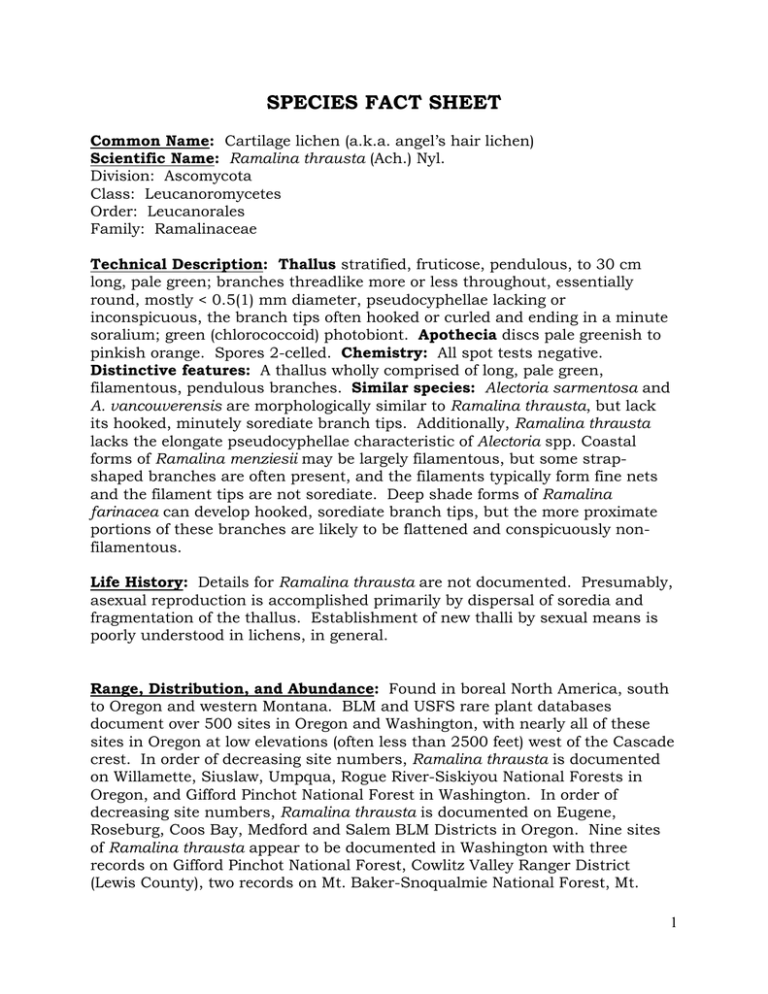SPECIES FACT SHEET
advertisement

SPECIES FACT SHEET Common Name: Cartilage lichen (a.k.a. angel’s hair lichen) Scientific Name: Ramalina thrausta (Ach.) Nyl. Division: Ascomycota Class: Leucanoromycetes Order: Leucanorales Family: Ramalinaceae Technical Description: Thallus stratified, fruticose, pendulous, to 30 cm long, pale green; branches threadlike more or less throughout, essentially round, mostly < 0.5(1) mm diameter, pseudocyphellae lacking or inconspicuous, the branch tips often hooked or curled and ending in a minute soralium; green (chlorococcoid) photobiont. Apothecia discs pale greenish to pinkish orange. Spores 2-celled. Chemistry: All spot tests negative. Distinctive features: A thallus wholly comprised of long, pale green, filamentous, pendulous branches. Similar species: Alectoria sarmentosa and A. vancouverensis are morphologically similar to Ramalina thrausta, but lack its hooked, minutely sorediate branch tips. Additionally, Ramalina thrausta lacks the elongate pseudocyphellae characteristic of Alectoria spp. Coastal forms of Ramalina menziesii may be largely filamentous, but some strapshaped branches are often present, and the filaments typically form fine nets and the filament tips are not sorediate. Deep shade forms of Ramalina farinacea can develop hooked, sorediate branch tips, but the more proximate portions of these branches are likely to be flattened and conspicuously nonfilamentous. Life History: Details for Ramalina thrausta are not documented. Presumably, asexual reproduction is accomplished primarily by dispersal of soredia and fragmentation of the thallus. Establishment of new thalli by sexual means is poorly understood in lichens, in general. Range, Distribution, and Abundance: Found in boreal North America, south to Oregon and western Montana. BLM and USFS rare plant databases document over 500 sites in Oregon and Washington, with nearly all of these sites in Oregon at low elevations (often less than 2500 feet) west of the Cascade crest. In order of decreasing site numbers, Ramalina thrausta is documented on Willamette, Siuslaw, Umpqua, Rogue River-Siskiyou National Forests in Oregon, and Gifford Pinchot National Forest in Washington. In order of decreasing site numbers, Ramalina thrausta is documented on Eugene, Roseburg, Coos Bay, Medford and Salem BLM Districts in Oregon. Nine sites of Ramalina thrausta appear to be documented in Washington with three records on Gifford Pinchot National Forest, Cowlitz Valley Ranger District (Lewis County), two records on Mt. Baker-Snoqualmie National Forest, Mt. 1 Baker Ranger District, (Whatcom County), one record on Colville National Forest, Sullivan Lake Ranger District (Pend Oreille County), and three records on state or private lands (Pacific, Clatsop and Skagit Counties). Habitat and distribution of known sites within Washington suggest that Ramalina thrausta should be suspected to occur on Olympic National Forest. Habitat Associations: Largely occurring in low elevation conifer forests that frequently include a hardwood component, where it occurs on branches and boles of conifers and hardwoods, as well as understory shrubs. In Oregon, Ramalina thrausta most commonly western hemlock forest type (R6 USFS PotentialNaturalVegZone GIS layer). Other forest types include Douglas fir, and to a much lesser degree, grand fir and Jeffrey pine; along coastal Oregon it is found in Sitka spruce forest. A relatively old, but very detailed description of habitats is presented in Derr et al., 2003. Sites in Washington range in elevation from near sea level to 2800 feet. Vegetation at two sites on Gifford Pinchot National Forest is described as 1) old western red cedar and Douglas fir, and 2) Douglas fir over vine maple, salal and Cascade barberry. The site on Colville National Forest occurs on open Engelman spruce intermixed with Betula glandulosa and Rhamnus alnifolia in a large groundwater-rich wetland at an elevation of 2960 feet. Threats: Forest management actions that remove occupied host trees or shrubs, or treatments that markedly alter microclimate by changes in amount of light, moisture and temperature at occupied sites, may threaten local persistence of small populations. Conservation Considerations: With more than 500 records from lands managed by BLM and USFS in Oregon, the persistence of Ramalina thrausta in this state would appear to be secure. In Washington, consider efforts to relocate sites on federal land, better determine extent of the local populations, and periodically monitor condition. Consider efforts to identify highly suitable habitat and then periodically conduct surveys in these habitats on Gifford Pinchot, Mt. Baker-Snoqualmie and Olympic National Forests. Conservation rankings: G4G5; WANHP S2, proposed threatened; not listed by ORBIC. Preparer: Rick Dewey Date Completed: 6/18/2015; updated on 2/6/2016. References: Ahlenslager, Kathy. 2016. Personal communication on 2/5/2016 concerning a recent Ramalina thrausta record on Colville National Forest. Ahlenslager is the Forest Botanist on Colville National Forest. 2 Consortium of Pacific Northwest Herbaria at www.pnwherbaria.org, visited 6/9/2015. Derr, Chiska, Richard Helliwell, Andrea Ruchty, Lisa Hoover, Linda Geiser, David Lebo and John Davis. 2003. Survey Protocols for Survey and Manage Category A & C Lichens, Version 2.1; Joint publication of U.S. Department of Interior Bureau of Land Management and U.S. Fish and Wildlife Service, and U.S.D.A. Forest Service. Goward, Trevor. 1994. The Lichens of British Columbia, Illustrated Keys, Part 2 – Fruticose Species. Ministry of Forests Research Program. McCune, Bruce and Linda Geiser. 1997. Macrolichens of the Pacific Northwest. Oregon State University Press in co-publication with the U.S.D.A. Forest Service. Oregon Biodiversity Information Center. 2013. Rare, Threatened and Endangered Species of Oregon. Institute for Natural Resources, Portland State University, Portland, Oregon. Washington State Department of Natural Resources. 2014. Washington Natural Heritage Program Proposed List of Rare Lichens at <www1.dnr.wa.gov/nhp/refdesk/lists/lichens.html> Accessed 6/9/2015. Ways of Enlichenment Photo Gallery @ www.waysofenlichenment.net/lichens. 3 Ramalina thrausta (Ach.) Nyl. Photographed by Jason Hollinger, 10/13/2013, British Columbia, Wells Gray, Clearwater Valley, on Picea. Photo accessed at http://www.waysofenlichenment.net 4 Photographed by Jason Hollinger, 10/13/2010, British Columbia, Wells Gray, Clearwater Valley, on Pseudotsuga. Comparison of Usnea scabrata, Alectoria sarmentosa and Ramalina thrausta, all of which can grow on the same branch. Photo accessed at http://www.waysofenlichenment.net 5

